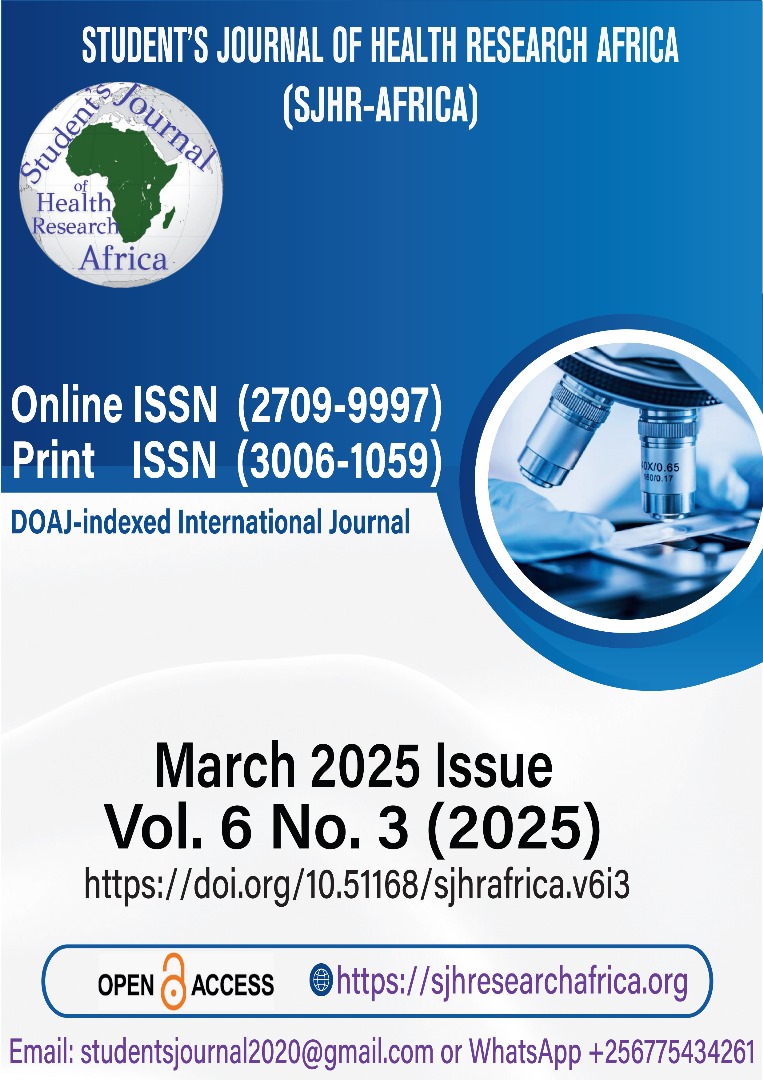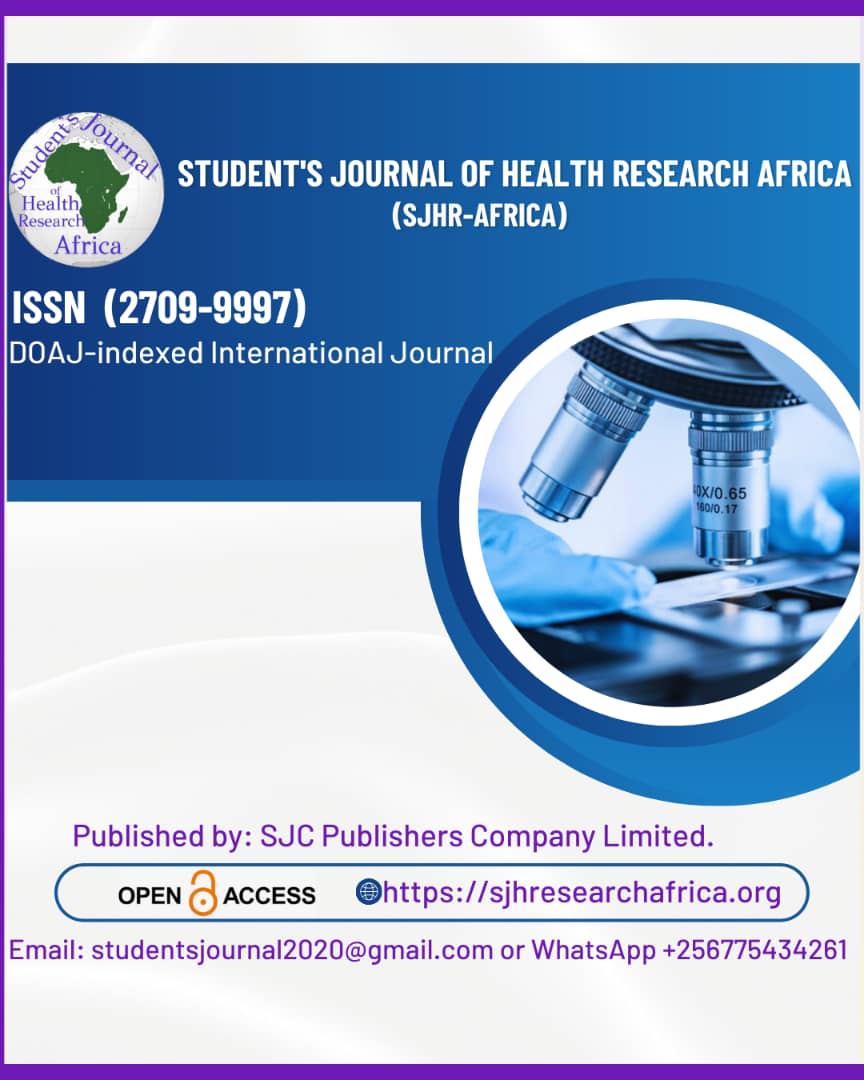ASSESSMENT OF PAIN AND FUNCTIONAL DISABILITY IN PATIENTS WITH KNEE OSTEOARTHRITIS: A CROSS-SECTIONAL STUDY.
DOI:
https://doi.org/10.51168/sjhrafrica.v6i3.1654Keywords:
Knee osteoarthritis, pain, functional disability, quality of life, Western Ontario and McMaster Universities Osteoarthritis Index (WOMAC), Short Form-36 Health Survey (SF-36), Visual Analogue Scale (VAS)Abstract
Background
Osteoarthritis (OA) is a degenerative joint disease that leads to pain, stiffness, and functional limitations, significantly affecting quality of life. Knee OA, the most prevalent form, impacts multiple joint structures and causes progressive disability. Understanding the relationship between pain, functional impairment, and quality of life is crucial for effective management. This study assesses the correlation among knee osteoarthritis, pain, functional impairment, and overall quality of life.
Methods
This cross-sectional study was conducted at Hi-tech Medical College and Hospital, Bhubaneswar (2020–2022) with 800 participants aged 50–65 years diagnosed with unilateral knee OA. Pain was assessed using the Visual Analogue Scale (VAS), functional disability with the WOMAC index, and quality of life using the SF-36 survey. Statistical analysis was performed using SPSS version 20, with Pearson correlation applied to assess associations between pain, functional disability, and quality of life (p < 0.05).
Results
Among 800 knee osteoarthritis patients (70% females, mean age 56.82 ± 4.75 years), the mean pain intensity (VAS) was 5.42 ± 1.09, and the total WOMAC score was 56.89 ± 8.47. Pain and functional disability showed a significant correlation (r = 0.285, p = 0.01), and higher disability was associated with lower quality of life (PCS: r = 0.595, MCS: r = 0.415, p < 0.05).
Conclusion
Greater pain and functional disability significantly reduce the quality of life in knee OA patients. Effective pain and disability management strategies are essential for improving patient well-being.
Recommendation
Integrated management approaches focusing on both pain relief and functional rehabilitation are recommended to enhance the quality of life in patients with knee osteoarthritis.
References
Felson DT, Lawrence RC, Dieppe PA, et al. Osteoarthritis: new insights. Part 1: The disease and its risk factors. Ann Intern Med. 2000; 133:635-46. https://doi.org/10.7326/0003-4819-133-8-200010170-00016
Fautrel B, Hilliquin P, Rozenberg S, et al. Impact of OA: results of a nationwide survey of 10,000 patients consulting for OA. Joint Bone Spine. 2005; 72:235-40. https://doi.org/10.1016/j.jbspin.2004.08.009
Fransen M, McConnell S, Harmer AR, Van der Esch M, Simic M, Bennell KL. Exercise for osteoarthritis of the knee. Cochrane Database Syst Rev. 2015; Issue 1. Art. No: CD004376. DOI: 10.1002/14651858.CD004376.pub3. https://doi.org/10.1002/14651858.CD004376.pub3
Alshami A. Knee osteoarthritis-related pain: a narrative review of diagnosis and treatment. Int J Health Sci. 2014;8(1):85-104. https://doi.org/10.12816/0006075
Odole AC, Ogunlana MO, Adegoke BOA, Ojonima F, Useh U. Depression, pain, and physical function in patients with osteoarthritis of the knee: implications for interprofessional care. Niger J Med Rehabil. 2015;18(1):1-16. Available from: http://www.njmr.org.ng https://doi.org/10.34058/njmr.v18i1.120
WHOQOL Group. The World Health Organization quality of life assessment (WHOQOL): position paper from the World Health Organization. Soc Sci Med. 1995;41(10):1403-9. https://doi.org/10.1016/0277-9536(95)00112-K
Cella DF, Tusky DS. Measuring quality of life today: methodological aspects. Oncology. 1990;5:29-38.
Revicki DA. Health-related quality of life in the evaluation of medical therapy for chronic illness. J Fam Pract. 1989;29(4):377-80.
Altman R, Asch E, Bloch D, Bole G, Borenstein D, Brandt K, Christy W, Cooke TD, Greenwald R, Hochberg M, Howell D. Development of criteria for the classification and reporting of osteoarthritis: classification of osteoarthritis of the knee. Arthritis Rheum. 1986;29(8):1039-49. https://doi.org/10.1002/art.1780290816
McConnell S, Kolopack P, Davis AM. The Western Ontario and McMaster Universities Osteoarthritis Index (WOMAC): a review of its utility and measurement properties. Arthritis Rheum. 2001;45:453-61. https://doi.org/10.1002/1529-0131(200110)45:5<453::AID-ART365>3.0.CO;2-W
Bellamy N, Buchanan WW, Goldsmith CH, et al. Validation study of WOMAC: a health status instrument for measuring clinically important patient-relevant outcomes to antirheumatic drug therapy in patients with osteoarthritis of the hip or knee. J Rheumatol. 1988;15:1833-40.
Kawano M, Araújo IL, Castro MC, Matos MA. Assessment of quality of life in patients with knee osteoarthritis. Acta Ortop Bras. 2015;23(6):307-10. https://doi.org/10.1590/1413-785220152306150596
Hootman JM, Macera CA, Ham SA, Helmick CG, Sniezek JE. Physical activity levels among the general US adult population and in adults with and without arthritis. Arthritis Care Res (Hoboken). 2003;49(1):129-35. https://doi.org/10.1002/art.10911
Steultjens MP, Dekker J, Bijlsma JW. Avoidance of activity and disability in patients with osteoarthritis of the knee: the mediating role of muscle strength. Arthritis Rheum. 2002;46(7):1784-8. https://doi.org/10.1002/art.10383
Walankar P, Jain A. Correlation between balance, fear of fall, and quality of life in osteoarthritis knee. Sch J App Med Sci. 2017;5(7B):2621-4.
Downloads
Published
How to Cite
Issue
Section
License
Copyright (c) 2025 Indranil Dey, Satotsna Patra, Samir Golder, Pritiranjan Patra

This work is licensed under a Creative Commons Attribution-NonCommercial-NoDerivatives 4.0 International License.






















